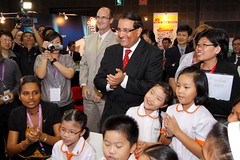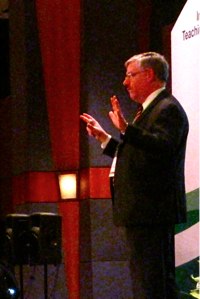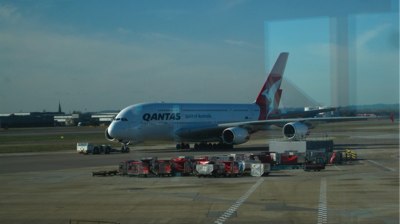I’m sitting in Michael Furdyk’s session on project based learning at the iCTLT conference. He’s a great presenter with a timely message. It wasn’t my first choice, because I spent just about all day yesterday in the spotlight rooms, and wanted to attend some of the local sessions today. Alas they were all full.
 |
|
The Minister of Education (center) witnessing a video conference between learners in Singapore and learners in New Zealand (photo by the mob from New Zealand)
|
iCTLT has been quite an experience and it’s given me a lot to think about. I saw a couple of products in the exhibitors’s hall that were new to me and so innovative, that I can’t yet wrap my mind around them. I’ll likely report on them later. One of the themes I did notice was the socialization of many products that you wouldn’t necessarily think of as sociable. For instance, Mathletics, out of Australia. Ostensibly a math-teaching tool, great fun is added when students can challenge other students in other parts of the world to Mathletic competitions. What intrigued me was how the competitions are actually fun to watch — availing classmates to sit behind, watch, and cheer their champion on. The company holds annual world-wide competitions, where the product is made available for free. I do not recall the numbers shared by my friend, Paul McMahon, but they were big. At this writing, there are 3,730 learners online competing or looking for competitors — and it’s Saturday morning in Asia.
Challenging Themes:
- Reinventing taxation for the 21st century
- Biotechnology rules
- Global financial architecture
- Illegal Drugs
- Trade, investment and competition rules
- Intellectual property rights
- E-commerce rules
- International labor & migration rules
|
Jenny Lewis, from Australia, shared a lot of information in her opening keynote this morning about the school, for which she serves as principal, and I am very glad that her slide deck is available at the conference download page. One of the best parts of her presentation was her questioning of why we still teach safe themes in our classes, like dinosaurs, Eskimos, etc. She then suggested that our students, within the context of curriculum, explore more important issues, such as… (see left).
Kevin Walsh’s closing keynote was a great treat for those who stayed and the high point of the conference for me. I am so glad that I resisted the nearly overwhelming temptation to escape back early to my hotel. [my notes]
Walsh, a quite unassuming looking man,
..directs Oracle’s centers for technology R&*D in China, Singapore, India, Australia, Japan and South Korea. He founded Oracle’s China Development Centers in 2001 and has since created Oracle’s technology innovation network spanning the entire Asian region. ((iCTLT 2010: International Conference on Teaching & Learning with Technology. Singapore: Minister of Education, 2010. 11. Print.)) (link)
 |
|
Oracle’s Kevin Walsh delivering the closing keynote address
|
Walsh started off talking about Web 2.0, what it means, and it’s impact. He also said that the Internet is getting larger, in that new kinds of devices are joining it, like mobile phones, other hand-held devices, televisions, and even our cars. He also suggested that Web 1.0 was a web of documents, while Web 2.0 has become “a web if individuals.” I would have disagreed with this distinction except for where he later took it.
It was also around this time that he said something that I wish he’d expanded upon. He said that “Computing has always been about looking backward.” I put a big [think about this later] tag on this item in my notes. On some j’lag-addled reflection, it seems that computing has, until recently, been about allowing us to do old things better, faster, and ultimately more cheaply. It’s been about automation. In my opinion, Web 2.0 has represented a move, to imagining and facilitating a more democratic, community-oriented, but individual-enriching future. Sometimes it does it well and sometimes it doesn’t (see “Dispute Finders & Claims of Ignoring Lincoln“).
Then Oracle’s innovator proceeded to define Web 3.0 — which always makes me cringe. It’s just one of those ideas that discussions of a new Web seem to beg for, but it just isn’t here yet — at least to a point where we can talk about it or define it. We won’t till we’re there. But Walsh presented an extremely compelling case for a Web that is become almost intelligent — a web that is coming to understand itself. He says that the Web will:
- Wrap around us
- Self-organize
- That we’ll be able to talk to it
- Touch it
- That the Web will disappear.
I think that what intrigued me the most was how we, without knowing it, in our daily interactions with an increasingly intelligent environment, will add content and understand to the web. As the Web gets to know us, it will help us do things, free us from many of the mundane things we have to do today, decisions we have to make.
Some might see this as dehumanizing — and I wouldn’t discourage this thought. We need to remain weary and advance with care. But I think that rather than dehumanizing us, it will more likely re-humanize us, allowing us to become more natural beings — freeing us from the slavery of our appliances.
Many thanks to ISTE and the Singapore Ministry of Education for inviting me to be a part of this.
Tags: warlick, conference, iCTLT2010, Singapore
 After about an hour’s delay in London, we enjoyed an amazing take-off bound for Singapore and the iCTLT (International Conference for Teaching and Learning with Technology). The take-off amazed me because of the size of this jet, an Airbus a380. Unlike the Boeing 747’s signature second floor hump in the front, the A380 is two floors all the way to the back of the plane. I am just behind the wing on the top floor sitting in a premium version of coach class (thanks, Brenda). It’s not business class or first class, but there’s gobs of room.
After about an hour’s delay in London, we enjoyed an amazing take-off bound for Singapore and the iCTLT (International Conference for Teaching and Learning with Technology). The take-off amazed me because of the size of this jet, an Airbus a380. Unlike the Boeing 747’s signature second floor hump in the front, the A380 is two floors all the way to the back of the plane. I am just behind the wing on the top floor sitting in a premium version of coach class (thanks, Brenda). It’s not business class or first class, but there’s gobs of room.

